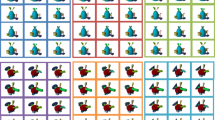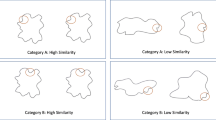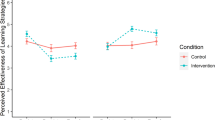Abstract
Observing category exemplars in an interleaved manner is more beneficial for inductive learning than blocked (massed) presentation, a phenomenon termed the interleaving effect on inductive learning. However, people tend to erroneously believe that massed is more beneficial than interleaved learning, and learners prefer the former during self-regulated learning. We report four experiments designed to investigate whether explicit instructions, which include individual performance feedback and the interleaving effect results from previous research, can (1) correct metacognitive illusions regarding the interleaving effect, (2) promote self-employment of interleaving, and (3) facilitate category learning. In addition, the current study explored (4) whether the intervention effect is long-lasting and (5) transferable to learning of categories in other domains. Experiments 1–4 established the effectiveness of the instruction intervention to enhance metacognitive appreciation of the interleaving effect, to promote self-employment of interleaving, and to facilitate learning of new categories. The intervention effect was long-lasting (at least 24 h; Experiment 2), and transferable to learning of categories in different domains (Experiments 3 and 4). These findings support the practical use of the instruction intervention.






Similar content being viewed by others
Data Availability
All data and experimental stimuli have been made publicly available via the Open Science Framework (OSF) at https://osf.io/ckdz9/.
Notes
A noteworthy point is that if a given participant only selected one artist to be studied using the interleaved strategy, all 12 artists’ paintings would be presented in the massed format because there were no other artists’ paintings to be inserted for the interleaved artist.
As shown in Table 2, the exact same patterns were observed in Experiments 2–4. For the sake of brevity, we do not discuss these results further.
References
Ariel, R., & Karpicke, J. D. (2018). Improving self-regulated learning with a retrieval practice intervention. Journal of Experimental Psychology: Applied, 24, 43–56. https://doi.org/10.1037/xap0000133
Ball, B. H., Klein, K. N., & Brewer, G. A. (2014). Processing fluency mediates the influence of perceptual information on monitoring learning of educationally relevant materials. Journal of Experimental Psychology: Applied, 20, 336–348. https://doi.org/10.1037/xap0000023
Birnbaum, M. S., Kornell, N., Bjork, E. L., & Bjork, A. R. (2013). Why interleaving enhances inductive learning: The roles of discrimination and retrieval. Memory & Cognition, 41, 392–402. https://doi.org/10.3758/s13421-012-0272-7
Blackwell, L. S. (2002). Psychological mediators of student achievement during the transition to junior high school: The role of implicit theories. Columbia University.
Brunmair, M., & Richter, T. (2019). Similarity matters: A meta-analysis of interleaved learning and its moderators. Psychological Bulletin, 145, 1029–1052. https://doi.org/10.1037/bul0000209
Carpenter, S. K., & Mueller, F. E. (2013). The effects of interleaving versus blocking on foreign language pronunciation learning. Memory & Cognition, 41, 671–682. https://doi.org/10.3758/s13421-012-0291-4
Cepeda, N. J., Pashler, H., Vul, E., Wixted, J. T., & Rohrer, D. (2006). Distributed practice in verbal recall tasks: A review and quantitative synthesis. Psychological Bulletin, 132, 354–380. https://doi.org/10.1037/0033-2909.132.3.354
Choi, H., & Lee, H. S. (2020). Knowing is not half the battle: The role of actual test experience in the forward testing effect. Educational Psychology Review, 32, 765–789. https://doi.org/10.1007/s10648-020-09518-0
Dweck, C. S., & Yeager, D. S. (2020). A growth mindset about intelligence. In G. M. Walton & A. J. Crum (Eds.), Handbook of wise interventions: How social psychology can help people change (pp. 9–35). The Guilford Press.
Eglington, L. G., & Kang, S. H. K. (2017). Interleaved presentation benefits science category learning. Journal of Applied Research in Memory and Cognition, 6, 475–485. https://doi.org/10.1016/j.jarmac.2017.07.005
Faul, F., Erdfelder, E., Lang, A. G., & Buchner, A. (2007). G* Power 3: A flexible statistical power analysis program for the social, behavioral, and biomedical sciences. Behavior Research Methods, 39, 175–191. https://doi.org/10.3758/BF03193146
Finn, B. (2008). Framing effects on metacognitive monitoring and control. Memory & Cognition, 36, 813–821. https://doi.org/10.3758/MC.36.4.813
Firth, J., Rivers, I., & Boyle, J. (2021). A systematic review of interleaving as a concept learning strategy. Review of Education, 9, 642–684. https://doi.org/10.1002/rev3.3266
Foster, N. L., Mueller, M., Was, C., Rawson, K. A., & Dunlosky, J. (2019). Why does interleaving improve math learning? The contributions of discriminative contrast and distributed practice. Memory & Cognition, 47, 1088–1101. https://doi.org/10.3758/s13421-019-00918-4
Holland, J. H., Holyoak, K. J., Nisbett, R. E., & Thagard, P. R. (1989). Induction: Processes of inference, learning, and discovery. Mit Press.
Hui, L., de Bruin, A. B. H., Donkers, J., & van Merriënboer, J. J. G. (2021). Does individual performance feedback increase the use of retrieval practice? Educational Psychology Review, 33, 1835-1857. https://doi.org/10.1007/s10648-021-09604-x
Jacoby, L. L., Wahlheim, C. N., & Coane, J. H. (2010). Test-enhanced learning of natural concepts: Effects on recognition memory, classification, and metacognition. Journal of Experimental Psychology: Learning, Memory, and Cognition, 36, 1441–1451. https://doi.org/10.1037/a0020636
Kang, S. H. K., & Pashler, H. (2012). Learning painting styles: Spacing is advantageous when it promotes discriminative contrast. Applied Cognitive Psychology, 26, 97–103. https://doi.org/10.1002/acp.1801
Kornell, N., & Bjork, R. A. (2008). Learning concepts and categories: Is spacing the “enemy” of induction? Psychological Science, 19, 585–592. https://doi.org/10.1111/j.1467-9280.2008.02127.x
Kornell, N., Castel, A. D., Eich, T. S., & Bjork, R. A. (2010). Spacing as the friend of both memory and induction in young and older adults. Psychology and Aging, 25, 498–503. https://doi.org/10.1037/a0017807
Kornell, N., & Vaughn, K. E. (2018). In inductive category learning, people simultaneously block and space their studying using a strategy of being thorough and fair. Archives of Scientific Psychology, 6, 138–147. https://doi.org/10.1037/arc0000042
McDaniel, M. A., & Einstein, G. O. (2020). Training learning strategies to promote self-regulation and transfer: The knowledge, belief, commitment, and planning framework. Perspectives on Psychological Science, 15, 1363–1381. https://doi.org/10.1177/1745691620920723
Metcalfe, J., & Xu, J. (2016). People mind wander more during massed than spaced inductive learning. Journal of Experimental Psychology: Learning, Memory, and Cognition, 42, 978. https://doi.org/10.1037/xlm0000216
Pan, S. C., Tajran, J., Lovelett, J., Osuna, J., & Rickard, T. C. (2019). Does interleaved practice enhance foreign language learning? The effects of training schedule on Spanish verb conjugation skills. Journal of Educational Psychology, 111, 1172–1188. https://doi.org/10.1037/edu0000336
Rawson, K. A., Thomas, R. C., & Jacoby, L. L. (2015). The power of examples: Illustrative examples enhance conceptual learning of declarative concepts. Educational Psychology Review, 27, 483–504. https://doi.org/10.1007/s10648-014-9273-3
Rivers, M. L. (2021). Metacognition about practice testing: A review of learners’ beliefs, monitoring, and control of test-enhanced learning. Educational Psychology Review, 33, 823–662. https://doi.org/10.1007/s10648-020-09578-2
Roediger, H. L., & Karpicke, J. D. (2006). The power of testing memory: Basic research and implications for educational practice. Perspectives on Psychological Science, 17, 249–255. https://doi.org/10.1111/j.1745-6916.2006.00012.x
Rohrer, D., Dedrick, R. F., & Burgess, K. (2014). The benefit of interleaved mathematics practice is not limited to superficially similar kinds of problems. Psychonomic Bulletin & Review, 21, 1323–1330. https://doi.org/10.3758/s13423-014-0588-3
Rohrer, D., Dedrick, R. F., & Hartwig, M. K. (2020). The scarcity of interleaved practice in mathematics textbooks. Educational Psychology Review, 32, 873–883. https://doi.org/10.1007/s10648-020-09516-2
Rozenshtein, A., Pearson, G. D. N., Yan, S. X., Liu, A. Z., & Toy, D. (2016). Effect of massed versus interleaved teaching method on performance of students in radiology. Journal of the American College of Radiology, 13, 979–984. https://doi.org/10.1016/j.jacr.2016.03.031
Sana, F., Yan, V., & Kim, J. A. (2017). Study sequence matters for the inductive learning of cognitive concepts. Journal of Educational Psychology, 109, 84–98. https://doi.org/10.1037/edu0000119
Tauber, S. K., Dunlosky, J., Rawson, K. A., Wahlheim, C. N., & Jacoby, L. L. (2013). Self-regulated learning of a natural category: Do people interleave or block exemplars during study? Psychonomic Bulletin & Review, 20, 356–363. https://doi.org/10.3758/s13423-012-0319-6
Taylor, K., & Rohrer, D. (2010). The effects of interleaved practice. Applied Cognitive Psychology, 24, 837–848. https://doi.org/10.1002/acp.1598
Thule, E. J. (2005). Accuracy of metacognitive monitoring and learning of texts. (Master dissertation). University of Toronto (Canada), Ann Arbor. Retrieved from https://elibrary.ru/item.asp?id=9350467
Vlach, H. A., & Sandhofer, C. M. (2012). Distributing learning over time: The spacing effect in children’s acquisition and generalization of science concepts. Child Development, 8, 1137–1144. https://doi.org/10.1111/j.1467-8624.2012.01781.x
Wong, S. S. H., Low, A. C. M., Kang, S. H. K., & Lim, S. W. H. (2020). Learning music composers’ styles: To block or to interleave? Journal of Research in Music Education, 68, 156–174. https://doi.org/10.1177/0022429420908312
Yan, V. X., Bjork, E. L., & Bjork, R. A. (2016). On the difficulty of mending metacognitive illusions: A priori theories, fluency effects, and misattributions of the interleaving benefit. Journal of Experimental Psychology: General, 145, 918–933. https://doi.org/10.1037/xge0000177
Yan, V. X., Soderstrom, N. C., Seneviratna, G. S., Bjork, E. L., & Bjork, R. A. (2017). How should exemplars be sequenced in inductive learning? Empirical evidence versus learners’ opinions. Journal of Experimental Psychology: Applied, 23, 403–416. https://doi.org/10.1037/xap0000139
Yan, V. X., Schuetze, B. A., & Eglington, L. G. (2020). A review of the interleaving effect: Theories and lessons for future research. PsyArXiv. https://doi.org/10.31234/osf.io/ur6g7
Yang, C., & Shanks, D. R. (2018). The forward testing effect: Interim testing enhances inductive learning. Journal of Experimental Psychology: Learning, Memory & Cognition, 44, 485–492. https://doi.org/10.1037/xlm0000449
Yang, C., Potts, R., & Shanks, D. R. (2017). Metacognitive unawareness of the errorful generation benefit and its effects on self-regulated learning. Journal of Experimental Psychology: Learning, Memory, and Cognition, 43, 1073–1092. https://doi.org/10.1037/xlm0000363
Yang, C., Huang, T. S. T., & Shanks, D. R. (2018a). Perceptual fluency affects judgments of learning: The font size effect. Journal of Memory and Language, 99, 99–110. https://doi.org/10.1016/j.jml.2017.11.005
Yang, C., Potts, R., & Shanks, D. R. (2018b). Enhancing learning and retrieval of new information: A review of the forward testing effect. npj Science of Learning, 3, 8. https://doi.org/10.1038/s41539-018-0024-y
Yang, C., Sun, B., & Shanks, D. R. (2018c). The anchoring effect in metamemory monitoring. Memory & Cognition, 46, 384–397. https://doi.org/10.3758/s13421-017-0772-6
Yang, C., Luo, L., Vadillo, M. A., Yu, R., & Shanks, D. R. (2021a). Testing (quizzing) boosts classroom learning: A systematic and meta-analytic review. Psychological Bulletin, 147, 399–435. https://doi.org/10.1037/bul0000309
Yang, C., Yu, R., Hu, X., Luo, L., Huang, T., & Shanks, D. R. (2021b). How to assess the contributions of processing fluency and beliefs to the formation of judgments of learning: Methods and pitfalls. Metacognition and Learning, 16, 319–343. https://doi.org/10.1007/s11409-020-09254-4
Zulkiply, N., & Burt, J. S. (2013). The exemplar interleaving effect in inductive learning: Moderation by the difficulty of category discriminations. Memory & Cognition, 41, 16–27. https://doi.org/10.3758/s13421-012-0238-9
Zulkiply, N., McLean, J., Burt, J. S., & Bath, D. (2012). Spacing and induction: Application to exemplars presented as auditory and visual text. Learning and Instruction, 22, 215–221. https://doi.org/10.1016/j.learninstruc.2011.11.002
Funding
This research was supported by the Natural Science Foundation of China (32000742; 32171045), the Fundamental Research Funds for the Central Universities (2019NTSS28), and the UK Economic and Social Research Council (ES/S014616/1).
Author information
Authors and Affiliations
Corresponding authors
Additional information
Publisher's Note
Springer Nature remains neutral with regard to jurisdictional claims in published maps and institutional affiliations.
Supplementary Information
Below is the link to the electronic supplementary material.
Rights and permissions
About this article
Cite this article
Sun, Y., Shi, A., Zhao, W. et al. Long-Lasting Effects of an Instructional Intervention on Interleaving Preference in Inductive Learning and Transfer. Educ Psychol Rev 34, 1679–1707 (2022). https://doi.org/10.1007/s10648-022-09666-5
Accepted:
Published:
Issue Date:
DOI: https://doi.org/10.1007/s10648-022-09666-5




